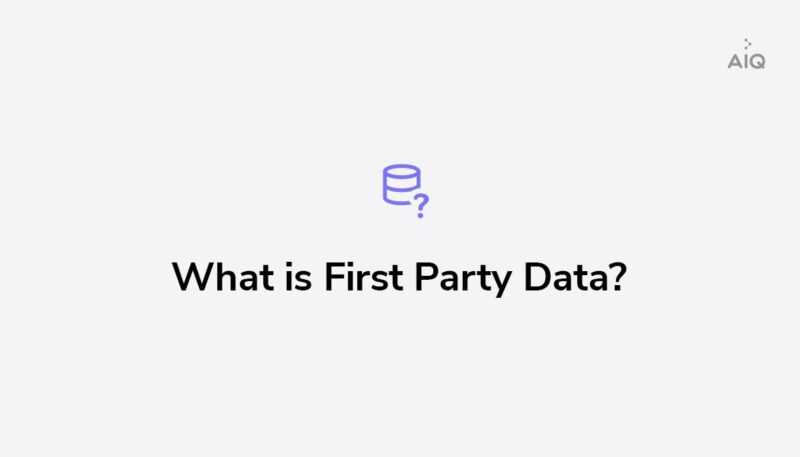What is First Party Data?

As a marketer or business person, you may have heard of 1st party data a lot and be wondering: “What is first party data?” It’s information your business collects directly from consumers. This is your own data collected directly from your company.
This data is the most valuable kind your business can gather. Without it, it’s impossible to build and scale authentic customer experiences.
Later in this post, we’ll talk about why it’s becoming more important than any other kind of customer data.
What is First Party Data? Let’s Dive In
A modern enterprise collects 1st party data both offline and online, across many customer touchpoints including:
- Websites
- Mobile apps
- Point of sale
- Digital commerce
- Call centers
- Surveys
Enterprises then store and manage this data across a variety of systems including:
- CRM
- Order management
- Data warehouses
- Data lakes
- Other systems that retain data about customer interactions
First party data can be explicitly shared with your brand by a customer audience – for instance when providing their personally identifiable information (PII) such as name, email, and address to complete an order. This common marketing strategy to collect consumer data during this sales phase, especially in digital marketing via interested website visitors, is ultimately used to run additional marketing campaigns that retarget these existing customers.
Other 1st party data is digital engagement data collected as part of observing customer behavior. This behavioral data can range from the campaigns the customer received, interactions with any of your digital marketing, sales, and support channels, or the log of content they consumed on your website prior to completing a transaction.
This data can also include customer satisfaction (CSAT) data points obtained via survey or through your customer service department. Sometimes, this party data is collected while the customer is still anonymous but later tied to the customer profile once they’ve chosen to identify themselves.
(Learn more about the types of valuable first-party data you can gather about customers.)
What is Second Party Data?
The simplest explanation of second party data is that it’s another company’s 1st party data. The brand collecting the consumer data (brand A) shares that data with you (brand B) directly, based on a business arrangement between your company and the data provider.
One of the oldest forms of 2nd party data sharing was when direct marketers would purchase a list of magazine subscribers from a publisher and then send promotional mailers out to the subscriber base.
Today, that model lives on in digital form and is leveraged in a variety of new ways:
- For example, insurance companies embed their products within the purchase workflows of other companies-think of cancellation insurance while booking a trip, or an extended warranty while buying an appliance online. The insurer collects second party information they might use to promote an extension or other products.
- As another example, CPG manufacturers work with retailers to acquire second party point-of-sale and loyalty data that help design targeted product promotions and offers.
Second party data is valuable because it is consumer data you wouldn’t otherwise be able to collect. In the past, many insurers and CPGs, for instance, didn’t sell directly to customers.
So without 2nd party data, it’d be impossible for the insurer to service the policy, and difficult for the CPG to understand the customer journey. (This is changing, with more and more insurers and CPGs launching direct-to-consumer operations that collect and rely on 1st party data.)
Shortcomings of second party data are that it’s typically limited in scope and limited in how you’re permitted to use it. And it usually takes a lot of one-off partnership work each time you want to onboard a new data source.
Additionally, it can be difficult to understand the full context in which the data is collected-resulting in uncertainty as to how receptive the consumer will be to messages from the second party.
What is Third Party Data?
Third party data is data you acquire from an intermediary who is not the direct collector of the data. Third party data is sold by aggregators who purchase it from publishers, websites, and other digital advertising platforms where it was originally generated.
Marketers have traditionally used 3rd party data for expanding their existing customer audiences and for new acquisition.
Using technology such as tracking cookies, aggregators can gather data points about millions and millions of anonymized individuals across multiple digital properties and devices. The audience data can include attributes in the categories of demographics, interests, behaviors, and more.
Marketers can select among the various audience attributes to programmatically target new audiences with messages and campaigns.
The benefit of 3rd party data and the programmatic advertising approach is that marketers can rapidly target very large audiences for acquisition campaigns. The downsides of third party data are:
- There’s no transparency into the original source of the data, so quality and relevance can be highly variable
- The data is available as part of an exchange or marketplace, so you are competing with others to access and message to similar audiences
- Third party data is the subject of growing privacy concerns and regulation
The Shift From 3rd Party Data to 1st Party Data
About 10 years ago, third party data—and the data management platforms (DMPs) that allowed marketers to utilize it—was one of the most important customer acquisition tools in the digital marketers’ arsenal. But things have changed drastically.
Today, the importance and utility of third party data and DMPs have greatly diminished. (Learn the difference between a CDP vs. DMP here).
At the same time, 1st party data has become more important than ever before. Here’s why:
Brands are now competing on customer experience
In the past, the competitive battle between brands was all about digital acquisition. But with rapidly rising acquisition costs, and consumers valuing a personalized experience more than even product or price, strategic imperatives have changed.
To thrive, brands must now set themselves apart from the competition based on superior customer experiences. To craft and deliver those experiences successfully, you need to intelligently utilize all the (1st party) data customers share with you, as well as the behavioral data captured at every point of interaction.
That’s why first party data (and to the extent it’s relevant and available, also second party data) is at the heart of great customer experiences.
Death of the cookie
Data management platforms (DMPs) were created specifically to reach new audiences based on 3rd party data. But DMP technology relies on 3rd party tracking cookies-and due to data privacy and regulatory challenges, the viability of tracking cookies is now greatly diminished.
Popular web browsers and add-on tools-through standards such as Apple’s Intelligent Tracking Prevention (ITP)- completely block these cookies as consumer privacy protection. Regulations such as GDPR and CCPA place tight restrictions on the use of all types of tracking cookies.
Convergence of ad spending on a few channels
Another value point of the DMP/third party data duo was the programmatic access to a broad network of web properties on which marketers could place advertising.
But with the emergence of Facebook, Google, and a handful of walled-garden platforms—and their next-gen targeting capabilities—as the true powerhouses of digital advertising, the value of those broad, DMP-powered networks has also greatly diminished.
Ad spend has primarily converged on these few modern channels, and for many acquisition use cases, the DMP-driven ad networks are approaching obsolescence.
Need to increase return on ad spend (ROAS)
Another result of the ad spend convergence on just a handful of platforms is that acquisition costs have continued to rise–that is, if you don’t take advantage of the ability to do more fine-grained targeting than ever before. Targeting more accurately increases yield and therefore lowers the cost per acquisition.
Increasingly, brands are turning to 1st party data to model best customers, and pass rich attributes about best customers directly into ad platforms like Google and Facebook to target lookalikes among the prospect base. The result is a significant drop in acquisition costs.
(Watch how Pandora Media modernized their martech to reduce ad spend and increase ROAS).
Harnessing the Power of Data With A CDP
It’s never been more important for brands to have a well-considered strategy for their 1st party data. As a result, new technology has come to the forefront, and it’s centered around managing, using, and governing first party data for purposes of deploying outstanding customer experiences through personalization.
It’s called a customer data platform (CDP). CDPs are all about putting the customer at the center of everything you do by making the most of the 1st party data that lies at the center of your customer relationships.
CDPs help brands harness the power of data
They do this by:
- Empowering all your teams with the analytics and tools they need to understand customers and craft differentiated experiences
- Orchestrating every experience across all your customer touchpoints so you can deliver what your customer needs, when and where they need it
- Bringing together all your customer data, and providing your CX professionals (including marketing, service, and sales) with governed access to everything you know about your customer
CDPs also have the ability to leverage second and third party data sources to enrich your all-important 1st party data assets. CDP’s allow for easy audience segmentation and give you the ability to create a hyper-personalized customer journey for each person in your database.
Be sure to check out our blog on the differences between CDP and CRM for more information.
Building a Profitable Data Strategy
ActionIQ’s technology and experienced team can help you empower your organization with the intelligence and agility you need to deliver memorable customer experiences that drive loyalty and growth.
If you’d like to enact a data strategy that puts your customer at the center of everything you do, contact ActionIQ today to learn more.




